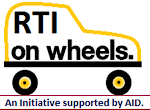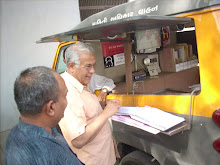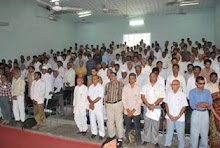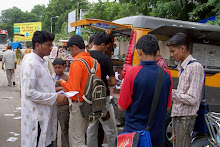Chandigarh
Tribune: Chandigarh: Wednesday, 21 January 2015.
The biggest
lesson of the last 10 years since the Right to Information Act came into force
is that Indian democracy, if it has to be meaningful, has to have a strong,
effective RTI regime. That regime has to be equally owned by those who govern
and those who are governed.
TEN years
after the Right to Information Act promised the country a “practical regime of
right to information for citizens”, what have we gained as citizens? Has it
helped to usher in required "transparency and accountability" in the
working of every public authority? That this promise was at all made by a power
elite notoriously resistant to scrutiny was itself an achievement requiring the
concerted efforts of remarkable social activists and a few good men and women
in the bureaucracy. But 10 years later that promise has still remained largely
that a promise.
That the Government of India has as yet not
deemed it fit to appoint a Chief Information Officer five months after the last
one retired underlines one of the myriad ways in which that promise could
falter.
For the
Government of India, the Right to Information Act has been, in G.M. Young's
immortal words, rather like being married to a duchess: the honour is almost
greater than the pleasure. If those in power have worn the accountability law
like a badge of their supposed “good governance”, it is also true they have
fought hard to undermine it in every way possible.
In fact, as
soon as the Act was passed by the UPA government in 2005 in the first blush of
its return to power after almost a decade in the wilderness, every important
government institution had sought exemption from its purview on the grounds of
protecting official secrets in the national interest. The bureaucracy which,
from the days of the British Raj had thrived on opaque government functioning
also demanded that file notings not be made public, once again in supposed
“national interest”.
Some five years
later the government put forward the suggestion that the Act be amended to
“discourage frivolous and vexatious representations”. At each juncture, it was
the swift response from civil society actors that helped to stymie the
concerted effort to re-introduce a veil of secrecy over government decision.
In 2013, when
the Chief Information Commissioner took the important initiative to bring all
national political parties under the Act's purview, political interests across
the spectrum swiftly came together and an amendment to the Act was framed to
counter it. Clearly, because access to information can potentially shake up the
status quo, those in power whether under the UPA or under the NDA; whether a
Manmohan Singh or a Narendra Modi, tend to be extremely wary of it. During his
election campaign for the 2014 general election, the latter had mockingly asked
an election crowd, “Has the RTI given you something for your stomach?”
There is, of
course, much to criticise about how the Act has been enforced. In 2013, the RTI
Assessment and Advocacy Group along with Samya-Centre for Equity Studies
recently reviewed its impact from 2011-2013 in a study entitled, “People's
Monitoring of the RTI Regime in India”. Many important trends emerged from this
exercise, including the formidable backlog in clearing applications that
exists. The review estimated that it would take a state like Madhya Pradesh 60
years to clear applications filed today and while West Bengal may be tad more
efficient in this regard, it would still take 17 years before a petition filed
in the state is attended to. In terms of providing information promptly, Delhi
did at least twice better than Bihar. We know how court cases moved at a
glacial pace, and it seems that RTI petitions were heading in the same
direction. The primary reason for this is a lack of personnel. If the judicial
backlog has been in large part created by the sorry shortage of judges, the
lack of a sufficient number of information commissioners was the single biggest
reason for the unconscionable delay in processing RTI applications.
Who were the
people filing these applications? What were their compulsions? These were just
among the more intriguing questions the review set out to answer and the data
was revealing. It found that women applicants, for instance, were insignificant
in number, constituting just 8 per cent of the total applicants. Equally
striking was the fact that although two-thirds of India's population lives in
villages, only 14 per cent of applicants were rural. Ironically, the lack of
information about the right to information seems to lie at the heart of this
and the authors of the review observed that the authorities have not taken
enough pains to raise general awareness about this right.
While
redressal of personal grievance was a significant motivation for the filing of
RTI complaints, a fair proportion of inquiries were linked to issues of public
interest, whether they concerned the actions of public authorities or the use
of public resources. This, of course, was highly contentious terrain. Over
these 10 years, many information activists have faced harassment, assaults and
death threats. In May 2008, there was the shocking case of Lalit Mehta. He was
killed for exposing corruption in rural job guarantee projects in Palamu,
Jharkhand, and his killers have eluded justice to date. The CBI has just
launched a fresh probe into the case involving Satish Shetty, who was hacked to
death after unearthing a major land-grab scam and alerting the police in
Lonavala, Maharashtra about it. Mehta and Shetty are just two among several
others who have paid with their lives for exposing unscrupulous and powerful
elements through the seemingly innocuous pursuit of information.
Here is
evidence of governmental apathy in putting together an effective protective
regime for RTI activists. The Whistleblowers Protection Act, 2011, was passed
in early 2014 but the rules are yet to be framed, so it has not been
operationalised. As the authors of the review underlined, what was urgently
required was to treat all forms of intimidation against RTI activists, once
proven, as punishable offences under criminal law.
The biggest lesson of the last 10 years since
the Act came into force is that Indian democracy, if it is to be meaningful,
has to have a strong, effective RTI regime that is equally owned by those who
govern and those who are governed. If public authorities “maintain all records
duly catalogued and indexed” and provide “as much information suo motu to the
public at regular intervals”, as is required under the RTI Act, perhaps the
need to file applications for information will decline.
A recent move
by the government to make available online all the replies provided by various
ministries is a step in the right direction. How about mainstreaming another
good suggestion: Setting up a national task force that is mandated to scan all
government records and make them available to the public through a searchable
data base?
The
writer is a senior fellow with the Indian Council of Social Science Research.














































































